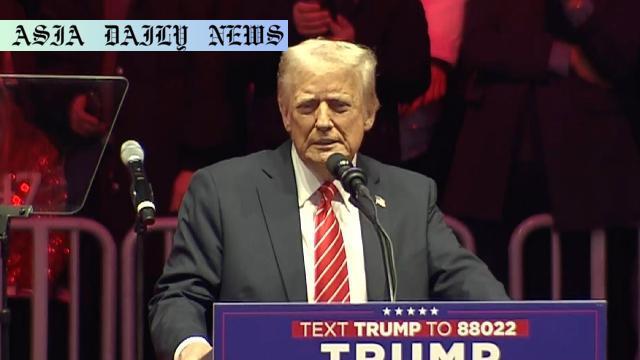Tariffs – The White House states US President Trump is considering imposing tariffs on imports from Canada, Mexico, and China starting February 1.
- Trump is mulling tariffs on imports from Canada, Mexico, and China.
- Proposed tariffs include 25% on Canada/Mexico and 10% on China.
- The plan is possibly set to start on February 1, as per the White House.
- Treasury Secretary Bessent proposes gradual universal tariffs; Trump opposes this.

Introduction: Trump’s Tariff Plans Target Key Trading Partners
The Trump administration is once again stirring debate with its proposal to implement significant tariffs on imports from Canada, Mexico, and China beginning February 1. Press Secretary Karoline Leavitt confirmed during her first briefing that the President is considering a 25% tariff on imports from Canada and Mexico, along with a 10% tariff on imports from China. These decisions mark a critical juncture for the United States trade policy, sparking reactions domestically and internationally.
Proposed Tariff Breakdown
Currently, the plan involves a sharp increase in duties on goods from neighboring countries and China. Canada and Mexico, two countries tied closely to the United States through the North American trade agreements, would each face a 25% tariff. China, a dominant force in global exports and a frequent target of Trump’s trade policies, would bear a 10% tariff on its exports. This follows a pattern established in Trump’s first administration of using tariffs as an economic weapon and as leverage in trade negotiations.
The President’s Vision: Higher Tariffs, Stricter Policies
Leavitt, speaking on behalf of the President, emphasized his approach of tough but ‘effective’ tariff plans. Although the recently-confirmed Treasury Secretary Scott Bessent proposed a universal tariff system starting at 2.5% and gradually increasing, Trump dismissed this idea. According to Leavitt, the President deemed the 2.5% rate to be too low and ineffective, signaling continued preference for aggressive trade measures.
Impact on International Relations
The potential tariffs are set to alter the dynamics of U.S. relationships with its closest allies and biggest competitor. Canada and Mexico, while economically interconnected with the U.S., may see these new tariffs as a violation of trust. Meanwhile, China, already embroiled in trade disputes with Washington, is likely to view the move as another provocation in the ongoing trade war.
Domestic Reactions and Economic Implications
Domestically, the proposed tariffs have led to mixed reactions. Economists warn about the possibility of higher consumer prices, disruptions to supply chains, and retaliatory measures from the affected countries. Businesses, particularly those reliant on imported goods, have expressed concerns over there not being sufficient preparation time or clarity on the tariffs’ specifics. Conversely, some industries such as domestic manufacturing sectors, which stand to benefit from reduced import competition, have applauded the idea.
Challenges Ahead: Uncertainties and Decision-Making
As February 1 approaches, much uncertainty surrounds the issue. Details on how these tariffs would be implemented, the exemptions that may apply, and the potential long-term economic impact remain unclear. Further complicating the matter, opposition voices within the administration and Congress have voiced concerns about this policy escalation straining economic recovery.
A Historical Perspective
Trump’s reliance on tariffs as a trade strategy harks back to his first administration, where similar measures were introduced against China and the European Union. At the time, the policy succeeded in securing some trade deals but at the cost of strained bilateral relationships and economic retaliations. Analysts are now questioning whether repeating this approach will yield long-term benefits or simply reignite old tensions.
Conclusion: A Tense Precedent
The proposed tariffs raise crucial questions regarding the future of U.S. trade policy, the effectiveness of aggressive economic measures, and the broader implications for global trade dynamics. With less than a month left before the potential tariff implementation date, all eyes are on the White House as the world braces for a decision with far-reaching consequences.



Commentary
The Challenges of Protectionism in Trade Policy
President Trump’s proposed tariffs on Canada, Mexico, and China reflect a familiar pattern in his approach to international trade: prioritize domestic industry while pressuring foreign governments. However, this approach is not without its challenges and risks, both economically and diplomatically.
On one hand, a tariff hike has the potential to strengthen certain domestic industries by reducing competition from imported goods. This may align with Trump’s ‘America First’ strategy and appeal to specific voter bases. Yet, on closer analysis, it’s crucial to recognize that tariffs have broader ripple effects—for instance, raising costs for U.S. businesses that rely on imports and ultimately increasing prices for consumers. Past experiences from Trump’s first term showed limited success in leveraging tariffs for fairness in trade agreements.
Global Implications of U.S. Trade Decisions
Another significant consideration is the global response. Trade partners like Canada and Mexico could respond with their own tariffs, resulting in a tit-for-tat escalation that harms both sides. For China, which has already faced punitive measures from the U.S., these additional tariffs would likely harden an already contentious relationship. It’s worth questioning whether this approach ultimately fosters cooperation or leads to fragmentation in the global trade ecosystem.
As February 1 approaches, it’s essential for policymakers to weigh the long-term consequences of such aggressive trade moves. A balanced approach—one that considers both domestic gains and international repercussions—might prove more sustainable and beneficial for the U.S. economy over time. With all that said, the final outcome remains to be seen.